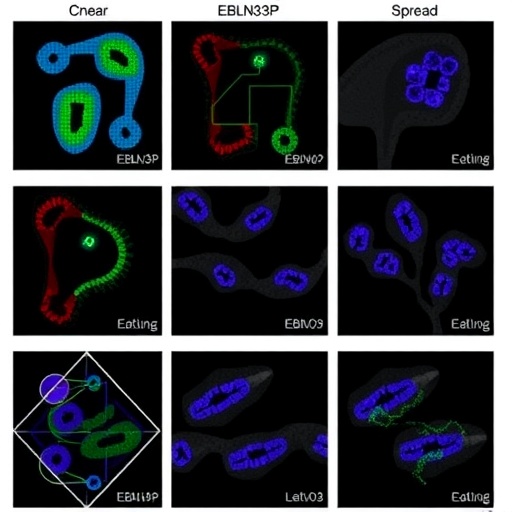Emerging research in the field of cancer biology has opened new horizons regarding the genetic underpinnings of tumor development and progression. The discovery of long non-coding RNAs (lncRNAs) has reshaped our understanding of molecular mechanisms driving cancer. In this context, a significant study conducted by Zong, Shen, Wang, and colleagues sheds light on the role of lncRNA EBLN3P in gastric cancer, profoundly impacting our knowledge of tumor biology.
Gastric cancer, one of the leading causes of cancer-related mortality worldwide, is characterized by its aggressive nature and poor prognosis. Traditionally, the focus has been on genetic mutations and protein-coding genes, but the role of non-coding RNAs has been increasingly recognized. Among these, lncRNAs have emerged as pivotal regulators of cellular processes, particularly in cancer. The study published in Biochemical Genetics provides a compelling narrative of how lncRNA EBLN3P operates within the complex regulatory networks of gastric cancer cells.
LncRNA EBLN3P has been identified as a crucial player in promoting cancer cell proliferation. The researchers observed that increased levels of EBLN3P corresponded with enhanced growth rates in gastric cancer cell lines. This finding indicates that EBLN3P may function by modulating key signaling pathways that control cell division. The mechanistic insights into how EBLN3P achieves this are essential for understanding its potential as a therapeutic target.
Moreover, the study highlights the relationship between EBLN3P and the tumor microenvironment. Tumorigenesis is not solely an intrinsic cellular process; rather, it is profoundly shaped by interactions with surrounding stromal cells, immune cells, and extracellular components. EBLN3P appears to influence these interactions, leading to a more favorable environment for cancer progression. This aspect of EBLN3P function emphasizes the need to consider the tumor’s ecosystem in developing effective treatment strategies.
Metastasis remains a central challenge in the management of gastric cancer due to its association with lethal outcomes. The research uncovered a correlation between EBLN3P levels and the metastatic potential of gastric cancer cells. Specifically, elevated EBLN3P expression was linked to enhanced migration and invasion capabilities, hallmarks of metastatic behavior. This finding is significant because it suggests that targeting EBLN3P could hinder the spread of cancer, thereby improving patient outcomes.
Stemness, the property that allows cancer cells to exhibit stem cell-like characteristics, is another crucial aspect explored in this study. The researchers found that EBLN3P not only promotes proliferation and metastasis but also enhances the stemness of gastric cancer cells. This is particularly concerning, as increased stemness is associated with resistance to conventional therapies and a greater likelihood of recurrence. Understanding the mechanisms through which EBLN3P fuels stemness can inform the development of targeted interventions to combat therapy resistance.
At the molecular level, the study identifies the interaction between EBLN3P and miR-141-3p as a critical pathway mediating its effects. MiR-141-3p, a well-known microRNA involved in various cellular processes, acts as a suppressor of HMGCS1, an enzyme integral to cholesterol biosynthesis and cellular metabolism. The researchers demonstrated that EBLN3P can inhibit miR-141-3p, thus promoting HMGCS1 expression and contributing to the aggressive behavior of gastric cancer cells. This connection between lncRNAs, microRNAs, and metabolic regulators highlights the complexity of gene regulation in cancer progression.
The implications of these findings extend beyond the laboratory. If EBLN3P can be validated as a therapeutic target, novel treatment modalities could be developed. For instance, strategies aimed at inhibiting EBLN3P could be explored to reduce proliferation and metastasis while simultaneously decreasing stemness in gastric tumors. This dual-action approach could enhance the efficacy of existing therapies, providing a more robust arsenal against this formidable disease.
Furthermore, the study adds to the growing body of literature elucidating the role of lncRNAs in cancer genetics. The unexpected involvement of non-coding RNAs in critical cellular functions challenges the historical focus on only protein-coding genes and underscores the need for comprehensive genomic studies in cancer research. As these non-coding RNAs continue to be characterized, we may discover new biomarkers for diagnosis, prognosis, and therapeutic response.
Despite the promising findings surrounding EBLN3P, several questions remain unanswered. Future research should aim to unravel the broader signaling networks in which EBLN3P operates and explore its interactions with other lncRNAs and cellular pathways. Additionally, clinical studies are imperative to assess the relevance of EBLN3P in patient samples, which could validate its potential as a prognostic marker and therapeutic target.
In conclusion, the research conducted by Zong, Shen, Wang, and colleagues offers profound insights into the role of lncRNA EBLN3P in gastric cancer. By promoting proliferation, metastasis, and stemness, EBLN3P emerges as a vital factor in the progression of this lethal disease. This study not only enriches our understanding of cancer biology but also points toward novel therapeutic avenues that could ultimately improve patient outcomes.
As cancer research continues to evolve, the focus on non-coding RNAs like EBLN3P represents a critical shift. Embracing these complex regulatory elements may unveil new strategies for combating cancer’s most challenging aspects, ultimately leading to a future where more effective treatments are available to patients across the globe.
Subject of Research: The role of lncRNA EBLN3P in gastric cancer proliferation, metastasis, and stemness.
Article Title: lncRNA EBLN3P Promotes Proliferation, Metastasis and Stemness of Gastric Cancer Cells via miR-141-3p/HMGCS1.
Article References:
Zong, Y., Shen, J., Wang, L. et al. lncRNA EBLN3P Promotes Proliferation, Metastasis and Stemness of Gastric Cancer Cells via miR-141-3p/HMGCS1.
Biochem Genet (2025). https://doi.org/10.1007/s10528-025-11235-8
Image Credits: AI Generated
DOI: 10.1007/s10528-025-11235-8
Keywords: gastric cancer, lncRNA, EBLN3P, miR-141-3p, metastasis, stemness, HMGCS1, cancer research, non-coding RNA.




